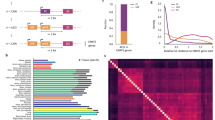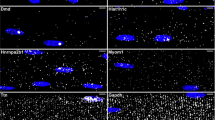Abstract
The largest known gene is the human dystrophin gene, which has 79 exons spanning at least 2,300 kilobases (kb). Transcript accumulation was monitored from four regions of the gene following induction of expression in muscle cell cultures. Quantitative reverse transcription–polymerase chain reaction (RT–PCR) results indicate that approximately 12 h are required for transcription of 1,770 kb (at an average elongation rate of 2.4 kb min−1), extrapolating to a transcription time of 16 h for the complete gene. Accumulation profiles for spliced and total transcript demonstrated that transcripts are spliced at the 5′ end before transcription is complete providing strong evidence for cotranscriptional splicing. The rate of transcript accumulation was reduced at the 3′ end of the gene relative to the 5′ end, perhaps due to premature termination of transcription complexes.
This is a preview of subscription content, access via your institution
Access options
Subscribe to this journal
Receive 12 print issues and online access
$209.00 per year
only $17.42 per issue
Buy this article
- Purchase on Springer Link
- Instant access to full article PDF
Prices may be subject to local taxes which are calculated during checkout
Similar content being viewed by others
References
Den Dunnen, J.Y. et al. Topography of the Duchenne muscular dystrophy (DMD) gene: FIGE and cDNA analysis of 194 cases reveals 115 deletions and 13 duplications. Am. J. hum. Genet. 45, 835–847 (1989).
Coffey, A.J. et al. Construction of a 2.6-Mb contig In yeast artificial chromosomes spanning the human dystrophin gene using an STS-based approach. Genomics 12, 474–484 (1992).
Monaco, A.P., Walker, A.P., Millwood, I., Larin, Z. & Lehrach, H. A yeast artificial chromosome contig containing the complete Duchenne muscular dystrophy gene. Genomics 12, 465–473 (1992).
Roberts, R.G., Coffey, A.J., Bobrow, M. & Bentley, D.R. Determination of the exon structure of the distal portion of the dystrophin gene by vectorette PCR. Genomics 13, 942–950 (1992).
Koenig, M., Monaco, A.P. & Kunkel, L.M. The complete sequence of dystrophin predicts a rod-shaped cytoskeletal protein. Cell 53, 219–228 (1988).
Ucker, D.S. & Yamamoto, K.R. Early events in the stimulation of mammary tumor virus RNA synthesis by glucocorticoids. J. biol. Chem. 259, 7416–7420 (1984).
Sehgal, P.B., Derman, E., Molloy, G.R., Tamm, I. & Darnell, J.E. 5-6-Dichloro-1-B-D-ribofuranosylbenzimide inhibits initiation of nuclear heterogeneous RNA chains in Hala cells. Science 194, 431–433 (1976).
Lederfein, D., Yaffe, D. & Nudel, U. A housekeeping type promoter, located in the 3′ region of the Duchenne muscular dystrophy gene, controls the expression of Dp71, a major product of the gene. Hum. molec. Genet. 2, 1883–1888 (1993).
Gorecki, D.C. et al. Expression of four alternative dystrophin transcripts in brain regions regulated by different promoters. Hum. molec. Genet. 1, 505–510 (1992).
Byers, T.J., Lidov, H.G.W. & Kunkel, L.M. An alternative dystrophin transcript specific to peripheral nerve. Nature Genet. 4, 77–81 (1993).
Chelly, J., Montarras, D., Pinset, C., Berwald-Netter, Y. & Kaplan, J.C. Quantitative estimation of minor mRNAs by cDNA-polymerase chain reaction: application to dystrophin mRNA in cultured myogenic and brain cells. Eur. J. Biochem. 187, 691–698 (1990).
Nudel, U., Robzyk, K. & Yaffe, D. Expression of the putative Duchenne muscular dystrophy gene in differentiated myogenic cell cultures and in the brain. Nature 331, 635–638 (1988).
Lev, A.A., Feener, C.C., Kunkel, L.M. & Brown, R.H. Expression of the Duchenne's muscular dystrophy gene in cultured muscle cells. J. biol. Chem. 262, 15817–15820 (1987).
Klamut, H.J., Gangopadhyay, S.B., Worton, R.G. & Ray, P.N. Molecular and functional analysis of the muscle-specific promoter region of the Duchenne muscular dystrophy gene. Molec. cell. Biol. 10, 193–205 (1990).
Krause, M. & Hirsh, D. A trans-spliced leader sequence on actin mRNA in C. elegans. Cell 49, 753–761 (1987).
Feener, C.A., Koenig, M. & Kunkel, L.M. Alternative splicing of human dystrophin mRNA generates isoforms at the carboxy terminus. Nature 338, 509–511 (1989).
Bies, R.D. et al. Human and murine dystrophin mRNA transcripts are differentially expressed during skeletal muscle, heart & brain development. Nucl. Acids Res. 20, 1725–1731 (1992).
Bar, S. et al. A novel product of the Duchenne muscular dystrophy gene which greatly differs from known isoforms in Its structure and tissue distribution. Biochem. J. 272, 557–560 (1990).
Byers, T.J., Lidov, H.G.W. & Kunkel, L.M. An alternative dystrophin transcript specific to peripheral nerve. Nature Genet. 4, 77–81 (1993).
Hugnot, J.P. et al. Distal transcript of the dystrophin gene initiated from an alternative first exon and encoding a 75-kDa protein widely distributed in non-muscle tissues. Proc. natn. Acad. Sci. U.S.A. 89, 7506–7510 (1992).
Lederfein, D. et al. A 71-kilodalton protein is a major product of the Duchenne muscular dystrophy gene in brain and other non-muscle tissues. Proc. natn. Acad. Sci. U.S.A. 89, 5346–5350 (1992).
Thummel, C.S., Burtis, K.C., Hogness, D.S. Spatial and temporal patterns of E74 transcription during drosophila development. Cell 61, 101–111 (1990).
Karim, F.D. & Thummel, C.S. Ecdysone coordinates the timing and amounts of E74A and E74B trancription in Drosophlia. Genes Dev. 5, 1067–1079 (1991).
Shermoen, A.W. & O'Farrell, P.H. Progression of the cell cycle through mitosis leads to abortion of nascent transcripts. Cell 67, 303–310 (1991).
Blau, H.M., Webster, C., Pavlath, G.K. & Chiu, C. Evidence for defective myoblasts in Duchenne muscular dystrophy. Adv Exp. Medicine Bio. 182, 85–110 (1985).
Nevins, J.R. & Darnell, J.E. Steps in the processing of Ad2 mRNA Poly (A)+ nuclear sequences are conserved and poly (A) addition precedes splicing. Cell 15, 1477–1493 (1978).
Ford, J.P. & Hus, M. Transcription pattern of in vivo-labeled late simian virus 40 RNA: equimolar transcription beyond the mRNA 3′ terminus. J. Virol. 28, 795–801 (1978).
Weber, J., Blanchard, J.M., Binsberg, H., Darnell, J.E. Order of polyadenylic acid addition and splicing events In early adenovirus mRNA formation. J. Virol. 33, 286–291 (1980).
Galli, G., Guise, J., Tucker, P.W., Nevins, J.R. Poly(A) site choice rather than splice site choice governs the regulated production of IgM heavy-chain RNAs. Proc. natn. Acad. Sci. U.S.A. 85, 2439–2443 (1988).
Beyer, A.L. & Osheim, Y.N. Splice site selection, rate of splicing & alternative splicing on nascent transcripts. Genes Dev. 2, 754–765 (1988).
LeMaire, M.F. & Thummel, C.S. Splicing precedes polyadenylatlon during drosophila E74A transcription. Molec. cell Biol. 10, 6059–6063 (1990).
Bauren, G. & Wieslander, L. Splicing of Balbiani ring 1 gene pre-mRNA occurs simultaneously with transcription. Cell 76, 183–192 (1994).
Zeevi, M., Nevins, J.R. & Darnell, J.E. Jr. Nuclear RNA is spliced in the absence of poly (A) addition. Cell 26, 39–46 (1981).
Abei, M. & Weissmann, C. Precision and orderliness in splicing. Trend Genet. 3, 102–107 (1987).
Reed, R. & Maniatis, T. A role for exon sequences and splice-site proximity in splice-site selection. Cell 46, 681–690 (1986).
Solnick, D. Alternative splicing caused by RNA secondary structure. Cell 43, 667–676 (1985).
Hedley, M.L. & Maniatis, T. Sex-specific splicing and polyadenylatlon of dsx pre-mRNA requires a sequence that binds specifically to tra-2 protein in vitro. Cell 65, 579–586 (1991).
Lee, H., Kraus, K.W., Wolfner, M.F. & Lis, J.T. DNA sequence requirements for generating paused polymerase at the start of hsp70. Genes Dev. 6, 284–295 (1992).
London, L., Keene, R.G. & Landick, R. Analysis of premature termination in c-myc during transcription by RNA polymerase II in a Hela nuclear extract. Molec. cell. Biol. 11, 4599–4615 (1991).
Spencer, C.A. & Groudine, M. Transcription elongation and eukaryotic gene regulation. Oncogene 5, 777–785 (1990).
MacDonald, R.J., Swift, G.H., Przybyla, A.E. & Chirgwin, J.M. Isolation of RNA using guanidinium salts. Meth. Enzymol. 152, 219–227 (1987).
Maniatis, T., Fritsch, E.F. & Sambrook, J. Molecular cloning: a laboratory manual. (Cold Spring Harbor Laboratory, New York, 1989).
Wang, M., Doyle, M.V. & Mark, D.F. Quantitation of mRNA by the polymerase chain reaction. Proc. natn. Acad. Scl. U.S.A. 86, 9717–9721 (1989).
Author information
Authors and Affiliations
Rights and permissions
About this article
Cite this article
Tennyson, C., Klamut, H. & Worton, R. The human dystrophin gene requires 16 hours to be transcribed and is cotranscriptionally spliced. Nat Genet 9, 184–190 (1995). https://doi.org/10.1038/ng0295-184
Received:
Accepted:
Issue Date:
DOI: https://doi.org/10.1038/ng0295-184
This article is cited by
-
Fixed and Distributed Gene Expression Time Delays in Reaction–Diffusion Systems
Bulletin of Mathematical Biology (2022)
-
Complexity of skeletal muscle degeneration: multi-systems pathophysiology and organ crosstalk in dystrophinopathy
Pflügers Archiv - European Journal of Physiology (2021)
-
The First Comprehensive Cohort of the Duchenne Muscular Dystrophy in Iranian Population: Mutation Spectrum of 314 Patients and Identifying Two Novel Nonsense Mutations
Journal of Molecular Neuroscience (2020)
-
The C- and G-value paradox with polyploidy, repeatomes, introns, phenomes and cell economy
Genes & Genomics (2020)
-
Multiplexed genome engineering by Cas12a and CRISPR arrays encoded on single transcripts
Nature Methods (2019)



